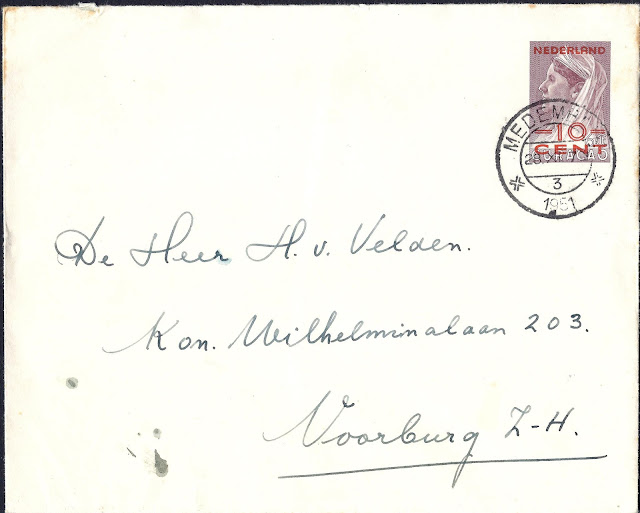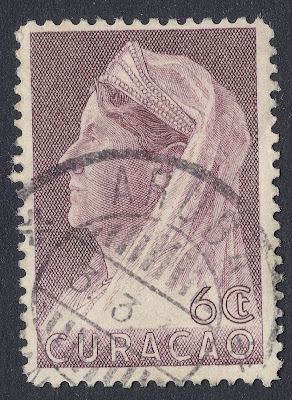 |
| Postal Stationery Envelope G.31 sent to Voorburg which was cancelled by the Medemblik 3 so-called 'Short Beam' postmark type on the 28th of November 1951 at 7 PM. |
This item lingered in my mind after I first saw it on Delcampe awhile ago. Not an extremely attractive entire I thought back then: a bit smudgy and bleak in a certain way. I scrolled on. For some reason I bumped into the cover again and fortunately I then did some actual research on the stationery envelope type. In the unsurpassed Geuzendam catalog for Dutch postal stationery, I found that the original envelop (without overprint) was purposed to be used on Curaçao from 1940 onwards, but for some reason the cover is only known to have been in circulation there between 1946 and 1956.
 |
| Postal Stationery Envelope G.31, recognizable because of the 'Nederland 10 cent' overprint in red. |
Out of the 222.400 (!) envelopes which were printed, 122.400 received the 'Nederland 10 cent' overprint in 1950. Confusingly enough, another number in the same catalogue states that the were only 92.803 envelopes which were overprinted. Let's - for the sake of clarity- just take the fictional but not incorrect number of 100.000 as the golden mean. Postal stationery has always suffered from unfair competition with stamps on cover, so I think it's fair to say about 1% or even less of this number of envelopes survives. 100.000/100 gives 1000. So in practice that means that less than 1000 of these envelopes might have made it into 2019: most of them even likely in unused state. That simple calculation made me realize how rare this stationery type of envelope actually is. A G.31 cancelled by a Medemblik short beam postmark is probably unique. And Geuzendam rates this envelop used at a mere € 2,- !
 |
| The 1936 stamp (NVPH 126) which is similar in design to the envelope. |
The weather on the 28th of November 1951 was stormy (5/6 bft) with severe gusts of wind along the coast (bft > 10). According to an article in the Dutch Leidse Courant of 29-11-1951, the storm reached its apogee during the evening - precisely the moment our stationery envelope was sent to Voorburg, a town near The Hague and therefore close to the coast. The severity of the storm and its sudden character caused the British S.S. Teeswood to break in twain after having grounded a sandbank near the island of Rottum.
 |
| The route which the crow might have flown between Medemblik (north) and Voorburg (south) if the weather would have been calm on the 28th of November. |







No comments:
Post a Comment